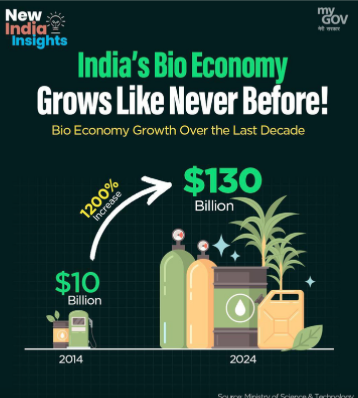Daily Current Affairs | March 27 2025
Important Topics from Current Affairs : 1) India BioEconomy Report 2) Protests at Bodh Gaya 3) National Judicial Appointments Commission (NJAC)
Jumbo IAS
3/27/20253 min read
1) India BioEconomy Report
The India BioEconomy Report, released by the Department of Biotechnology, says there is ample opportunity for this sector to grow to about $300 billion by 2030, & to $1 trillion by 2047.
The report has pegged the value of India’s bioeconomy in 2024 at more than $165 billion, accounting for over 4.2% of GDP.
Bioeconomy - It is the knowledge-based production and use of biological resources to provide products, processes, and services across all economic sectors.


Key Highlights
Increased Market Size - Bio-economy doubled from $86 billion (2020) to $165 billion (2024).
Jobs - Projected to generate 35 million jobs by 2030.
Start-ups - Number of companies grew from 5,365 in 2021 to 10,075 in 2024, expected to double by 2030.
48% value came from industrial bioeconomy (biofuels, bioplastics); 35% from pharma(vaccines).
India’s Achievements
Vaccine Revolution: India became a global leader in vaccine production post-COVID-19, boosting biotech infrastructure and innovation.
Biofuel Expansion: Ethanol blending programs and fermentation-based fuel production have surged, reducing fossil fuel dependency.
Academic & Research Ecosystem: Premier institutes like IISc, NCBS, NIBMG have expanded biotech R&D.
Digital Bio Solutions: AI-powered platforms for genome mapping, diagnostics, and precision farming are scaling rapidly.
Govt Steps
BioE3 Policy (2024): Launched to drive bio-based Economy, Environment, and Employment. Focus: biomanufacturing and research.
National Bioeconomy Mission (Proposed): Suggested in the report to coordinate policy and funding under one umbrella.
Single-Window Clearance: Recommended to ease biotech project approvals and remove regulatory delays.
Startup Ecosystem Boost: Bio-incubators and funding support for biotech startups are growing under DBT’s BIRAC.
Challenges
Regulatory Uncertainty: Delay in approval for GM crops hinders agricultural biotechnology despite proven productivity gains.
Geographical Disparity: 5 states(Maharashtra, Karnataka, Telangana, Andhra & Gujarat) contribute two-thirds of total value; NE and Eastern India underperform (<6%).
Skilled Workforce Shortage: Need for biotech-ready manpower across domains like bioinformatics, fermentation tech, and IP law.
Low Private Investment: Bioeconomy lags behind IT and pharma in attracting venture capital and FDI.
Standardisation Issues: Lack of bioresource inventories & of quality assurance frameworks reduce export potential.
2) Protests at Bodh Gaya
Bodh Gaya in Bihar is seeing Buddhists from across India gather to protest over the control of a shrine there, which is partly managed by Hindus, demanding that it be handed over exclusively to them.
The shrine in question is the Mahabodhi Temple, managed as per provisions of Bodh Gaya Temple Act, 1949.


Historical Significance
It is the place where Siddhartha Gautam attained enlightenment meditating under the Bodhi Tree.
Mauryan Emperor Ashoka, in 3rd Century BCE, constructed the first temple at the site comprising of a diamond throne (Vajrasana) and a shrine.
King Harshvardhana in 7th Century CE expanded the buddhist structures.
Its prominence declined during Islamic invasions but was later restored by British in 19th Century under Alexander Cunningham.
Significance of Mahabodhi Temple
Archeological Heritage - Recognised for its architectural brilliance and historical association with Buddha’s life.
World Heritage Site - Declared a World Heritage Site in 2002 for its outstanding universal value.
Spiritual Center - One of the four major Buddhist pilgrimage sites (alongside Lumbini, Sarnath, and Kushinagar).
Cultural Significance - Attracts pilgrims and scholars from Theravada, Mahayana, and Vajrayana traditions.
Significance of Mahabodhi Temple
Location : Situated in Gaya district, Bihar, India, near the Falgu River.
Mahabodhi Temple: 52-meter-tall pyramidal structure with intricate carvings.
Bodhi Tree: Direct descendant of the original tree under which Buddha meditated.
Vajrasana (Diamond Throne): Marks the exact spot of Buddha’s enlightenment.
Animesh Lochana Chaitya: Where Buddha spent the second week in meditation.
3) National Judicial Appointments Commission (NJAC)
Speaking on the issue of Judicial Accountability, Vice President referred to the National Judicial Appointments Commission Act passed by Parliament in 2014, saying that “things would have been different” if the Supreme Court had not struck it down.
NJAC - National Judicial Appointments Commission, a multi-stakeholder body to appoint judges to the SC and HCs.


About NJAC
Established through 99th Constitutional Amendment Act, 2014 and NJAC Act 2014.
Composition - CJI (Chairperson), 2 senior-most Judges of Supreme Court, Union Law Minister, 2 eminent persons.
Eminent Persons - Selected by PM, CJI, and LoP, with one from SC/ST, OBC, Women or Minorities.
Purpose - To replace Collegium system for judges appointments and transfers.
Need for NJAC
Opacity in Collegium System - Justice Ruma Pal termed the collegium as a “well-kept secret”, highlighting lack of transparency and accountability.
Checks and Balances - Inclusion of eminent persons and executive could bring external perspectives and help curb internal biases.
Meritocracy - Alleged lobbying and favouritism within collegium undermine merit and fairness in appointments.
Supreme Court’s Argument
Basic Structure Doctrine - In 2015, a 5-judge Bench (4:1) ruled NJAC unconstitutional as it violated the Basic Structure Doctrine.
Judicial Independence - Concerns over independence of judiciary and possible 3-3 deadlocks led to the rejection of the law.


